Running a logistics business is nowhere cheap. There are simply too many areas where you need to spend money — from vehicles and maintenance to salaries and employee benefits to the day-to-day running of your warehouses or distribution centers. But what if we told you there are ways to reduce these costs without sacrificing quality or service?
Most people would think that lowering business costs means looking for operational expenses the business should stop incurring. But that’s not always the case—sometimes, making certain investments can lead to lower business costs in the long run.
Read on to learn more about these investments and how they can help your logistics business save money in the long term.
Truck Scales
Investing in a truck weighing scale is one example of a move that can save your business money in the long run. Why? Because it ensures that your vehicles always carry the right amount of load, not a pound more.
Overloading trucks are dangerous and can damage your vehicles, leading to more frequent repairs and replacements. In the same vein, carrying too little load also means wasted space and fuel. Either way, it costs business money you could save and use for other expenses.
A truck scale will help you avoid these penalties by ensuring that your trucks always carry the right load. This can also reduce the time it takes to weigh your trucks and maintain the safety of your drivers and vehicles. Not to mention, it’s a one-time investment that will keep on giving—unlike repairs and replacements, which are costs you must repeatedly pay for.
Only buy from a reliable and certified vendor when searching for a truck scale. Choose one that already has a track record of sales and can offer various weighing scale models, so you can find one that’s perfect for your business needs.

Tetelematics Systems
Telematics is a technology that uses GPS tracking and sensors to collect data about your trucks and drivers. By gathering such data, you can find loopholes and optimize your fleet’s performance, reducing operational costs.
For instance, you can use telematics to plan more efficient routes for your drivers. This leads to less fuel consumption and wear and tear on your vehicles. Efficient routes lead to shorter delivery times, making your clients happy and setting your business apart from your competitors.
Another way to use telematics is to monitor your driver’s behavior. According to studies, up to 40% of truck drivers drive dangerously despite knowing the risks. This kind of driving endangers lives and also damages your vehicles, and incurs repair costs.
Telematics can help you avoid these accidents and costly repairs by monitoring your driver’s behavior and providing real-time feedback. You can then use this data to coach your drivers on improving their driving habits, making your fleet safer and lowering insurance premiums.
Tire Pressure Monitoring Systems
Tires are one of your truck’s most important—and expensive—parts. You must regularly replace the tires and ensure every tire has enough inflation. Poor inflation wears out your tires faster and can damage other parts of your truck and lead to accidents.
A tire pressure monitoring system (TPMS) helps you avoid all these problems. These work by continuously monitoring the pressure of each tire and alerting the driver when the pressure gets too low. This way, you can catch the problem early on and prevent further damage.
You can either buy a TPMS or have it installed as an aftermarket solution. This service has many reliable providers, so be sure to research and choose one that fits your business needs.
Warehouse Management Systems
If you operate a warehouse, you know just how laborious it is to keep track of all your inventory by hand. Not only is it time-consuming, but it’s also prone to error. A single mistake can lead to costly delays and unhappy customers.
A warehouse management system (WMS) helps you automate many tasks associated with warehouse operations, such as receiving, putting away, picking, and shipping. Doing so can free up your employees to do other tasks and minimize errors.
Such a system enables you to have real-time visibility into your inventory, so you can quickly adapt to changes in demand. Using this system, you can create more efficient picking routes and optimize storage space.
For example, you can use a WMS to create a “zone picking” system in your warehouse. In this system, you will assign an employee to a specific zone. They will then be responsible for picking all the items in that zone. This helps improve efficiency and accuracy.
When choosing a WMS, select one that integrates with your existing business system. This will make it easier to implement and use.
There are many ways to reduce business costs, but the abovementioned four investments are an excellent place to start. By making these investments, you can improve your bottom line and keep your business running smoothly. If you still lack any of these tools, you could already be wasting precious resources by paying for unnecessary costs that you can easily avoid.
